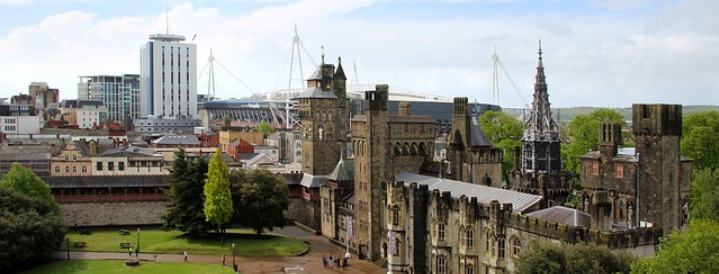Cardiff, capital city of Wales
Shaped in the 19th century, Cardiff’s architectural legacy mixes neoclassical elegance with colorful kitsch. Once dull and industrial, the city is now blossoming into one of Britain’s most welcoming cities, and it shines with scenic beauty, exciting modern buildings, glitzy waterfront neighborhoods, historic promenades, magnificent parklands and a wonderfully appealing blend of old and new.
The National Museum of Wales provides a great background to further exploration of Cardiff. Visitors can gain a deep understanding of the city’s cultural, political and social evolution from the museum’s detailed displays that span thousands of years of geologic and human history. The natural history galleries feature the skeletons of humpback whales, the world’s largest turtle and hundreds of brightly colored insects, while the art galleries showcase masterpieces by Van Gogh, Monet, Renoir, Matisse and Welsh artists like Gwen John, Thomas Jones, and Augustus John. There is really something for everyone in the museum, and it takes at least a full day to explore all the fascinating galleries.
After getting a good grasp of Welsh history at the museum, experience it first hand at some of the city’s oldest attractions. The imposingly beautiful 12th-century Llandaff Cathedral encompasses much of Cardiff’s fragmented past. It crumbled during the Middle Ages, was used as an animal shelter and alehouse during the Civil War and Reformation was rebuilt in the 19th century then damaged by German bombs during the Second World War. Today, visitors can walk through the giant arches to view the gracious vaulted interior and the shockingly modern “Majestas” sculpture that is illuminated by stunning stained glass windows.
Visitors can venture even further back in time when they visit the Cardiff Castle, one of the city’s most important historical relics. The site actually features a collection of castles that circle around a central green. The most notable are the 13th-century Black Tower and the 12th-century Norman keep, surrounded by Victorian-era reproductions of Roman walls originally built in the 3rd century. The entire complex feels like a historical fantasy world, and 50-minute guided tours take visitors through the interiors of nearly all the castles. The nearby by Interpretation Center offers additional insight and houses the Welch Regiment Museum, which details the military achievements of the country’s infantry.
The city’s most stunning green corridor spans the area next to the castle. Bute Park is a favorite place to picnic, fly kites and play cricket, and the park’s Animal Wall is legendary to the children of Cardiff. The wall’s stone figures of bears, lions, seals and other wildlife are rumored to come alive at night.
Cardiff Bay is the city’s architectural playground, featuring large open spaces, interesting buildings and eye-catching public art. The area is an outstanding example of urban renewal and regeneration, shedding its wasteland appearance in the late 1980s and transforming into a major commercial center packed with shops, restaurants and bars.
Other notable sights worth a visit in Cardiff include the educational and exciting National Coal Museum, Rhondda Heritage Park, the elegant 17th-century Llancaiach Fawr Manor, the National Roman Legion Museum, the 12th-century St. John the Baptist Parish Church and the Roald Dahl Plaza, dedicated to the beloved children’s author.
Cardiff has a well-rounded entertainment scene that includes world-renowned theaters, classical music venues and comedy clubs. The nightclub scene is lively, and St. Mary Street is always crowded with local revelers on the weekends. There, you can find a range of clubs spanning in style from intimate lounges to enormous super-clubs packed wall-to-wall with partygoers. The city also has some great live music venues, showcasing both local talents and international names.
Cardiff Geographical Location
Cardiff is located in the southeast of Wales and is its most populated city.
The population of Cardiff is approximately 842,000.
Cardiff Language
English is the predominant language in Wales although Welsh is very common as well. Welsh and English languages must legally be treated equally according to government legislation.
Cardiff Predominant Religion
- 72% Christian
- 18.5% None
- 8% Preferred Not to Answer
- 1.5% Other
Despite not being listed specifically in the religious demographics, Islam is the largest non-Christian religious group in Wales.
Cardiff Currency
The official currency of Wales is the Pound Sterling.
Cardiff Climate
It is often cloudy, wet, and windy in Cardiff with mild temperatures in the summer and cold winters.
Cardiff Main Attractions
- Cardiff Castle
- St Fagans: National History Museum
- The Llandaff Cardiff Ghost Walk
- Edwardian Civic Buildings
Other Attractions in Cardiff
- Millennium Stadium
- The National Museum Cardiff
- Norwegian Church
